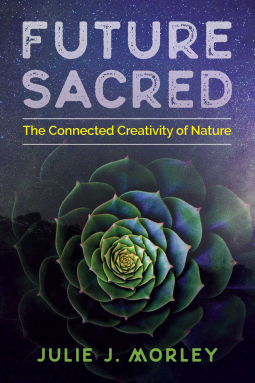
Future Sacred
The Connected Creativity of Nature
by Julie J. Morley
This title was previously available on NetGalley and is now archived.
Buy on Amazon
Buy on BN.com
Buy on Bookshop.org
*This page contains affiliate links, so we may earn a small commission when you make a purchase through links on our site at no additional cost to you.
Send NetGalley books directly to your Kindle or Kindle app
1
To read on a Kindle or Kindle app, please add kindle@netgalley.com as an approved email address to receive files in your Amazon account. Click here for step-by-step instructions.
2
Also find your Kindle email address within your Amazon account, and enter it here.
Pub Date Feb 12 2019 | Archive Date Oct 29 2018
Inner Traditions | Park Street Press
Talking about this book? Use #FutureSacred #NetGalley. More hashtag tips!
Description
Reveals how our survival depends on embracing complexity consciousness and relating to nature and all life as sacred
• Rejects the “survival of the fittest” narrative in favor of sacred symbiosis, creative cooperation, interdependence and complex thinking
• Provides examples from complexity studies, cultural history, philosophy, indigenous spirituality, biomimicry, and ecology to show how nature’s intelligence and creativity abound everywhere
• Documents how indigenous cultures lived in relative harmony with nature because they perceived themselves as part of the “ordered whole” of all life
In Future Sacred, Julie J. Morley offers a new perspective on the human connection to the cosmos by unveiling the connected creativity and sacred intelligence of nature. She rejects the “survival of the fittest” narrative--the idea that survival requires strife--and offers symbiosis and cooperation as nature’s path forward. She shows how an increasingly complex world demands increasingly complex consciousness. Our survival depends upon embracing “complexity consciousness,” understanding ourselves as part of nature, as well as relating to nature as sacred.
Morley begins by documenting how indigenous cultures lived in relative harmony with nature because they perceived themselves as part of the “ordered whole” of all life--until modernity introduced dualistic thinking, thus separating mind from matter, and humans from nature. The author deconstructs the fallacy behind social and neo-Darwinism and the materialist theories of “dead matter” versus those that offer a connection with the sentient mind of nature. She presents evidence from complexity studies, cultural history, philosophy, indigenous spirituality, biomimicry, and ecology, highlighting the idea that nature’s intelligence and creativity abound everywhere--from cells to cetaceans, from hydrogen to humans, from sunflowers to solar panels--and that all sentient beings contribute to the evolution of life as a whole, working together in sacred symbiosis.
Morley concludes that our sacred future depends on compassionately understanding and integrating multiple intelligences, seeing relationships and interdependence as fundamental and sacred, as well as honoring the experiences of all sentient beings. Instead of “mastery over nature,” we must shift toward synergy with nature--and with each other as diverse expressions of nature’s creativity.
• Rejects the “survival of the fittest” narrative in favor of sacred symbiosis, creative cooperation, interdependence and complex thinking
• Provides examples from complexity studies, cultural history, philosophy, indigenous spirituality, biomimicry, and ecology to show how nature’s intelligence and creativity abound everywhere
• Documents how indigenous cultures lived in relative harmony with nature because they perceived themselves as part of the “ordered whole” of all life
In Future Sacred, Julie J. Morley offers a new perspective on the human connection to the cosmos by unveiling the connected creativity and sacred intelligence of nature. She rejects the “survival of the fittest” narrative--the idea that survival requires strife--and offers symbiosis and cooperation as nature’s path forward. She shows how an increasingly complex world demands increasingly complex consciousness. Our survival depends upon embracing “complexity consciousness,” understanding ourselves as part of nature, as well as relating to nature as sacred.
Morley begins by documenting how indigenous cultures lived in relative harmony with nature because they perceived themselves as part of the “ordered whole” of all life--until modernity introduced dualistic thinking, thus separating mind from matter, and humans from nature. The author deconstructs the fallacy behind social and neo-Darwinism and the materialist theories of “dead matter” versus those that offer a connection with the sentient mind of nature. She presents evidence from complexity studies, cultural history, philosophy, indigenous spirituality, biomimicry, and ecology, highlighting the idea that nature’s intelligence and creativity abound everywhere--from cells to cetaceans, from hydrogen to humans, from sunflowers to solar panels--and that all sentient beings contribute to the evolution of life as a whole, working together in sacred symbiosis.
Morley concludes that our sacred future depends on compassionately understanding and integrating multiple intelligences, seeing relationships and interdependence as fundamental and sacred, as well as honoring the experiences of all sentient beings. Instead of “mastery over nature,” we must shift toward synergy with nature--and with each other as diverse expressions of nature’s creativity.
Available Editions
| EDITION | Other Format |
| ISBN | 9781620557686 |
| PRICE | $19.99 (USD) |
| PAGES | 272 |
Links
Featured Reviews
Future Sacred beautifully makes the case for humans to see themselves as a part of nature. The chapter on common shapes and patterns in nature was particularly interesting. However, this book is very academic and seemed targeted to a graduate student level. The author spent a lot of pages discussing the history of philosophy. If you're interested in philosophical arguments for environmentalism, this is the book for you. However, it is not for the average reader.



